Houses built to the fence line with dark roofs and tiny backyards leave their owners at the mercy of the climate crisis, experts say
On 4 January 2020, the western Sydney suburb of Penrith was one of the hottest places on Earth at 48.9C.
The heat that day, at the foot of the Blue Mountains, gave a brief window into what the future will be like in the city’s outer rings, soon to be home to more than 1.5 million people.
Climate change is no longer looming. It’s here.
Since records began, Australia has warmed by about 1.44C and rising, but the heat isn’t felt equally: few places are suffering as severely as western Sydney.
With plans to construct a new city around the Nancy Bird Walton airport at Badgerys Creek, and thousands of families moving into new release areas in the north-west and south-west, the time to insist on climate sensitive development is now, experts say.
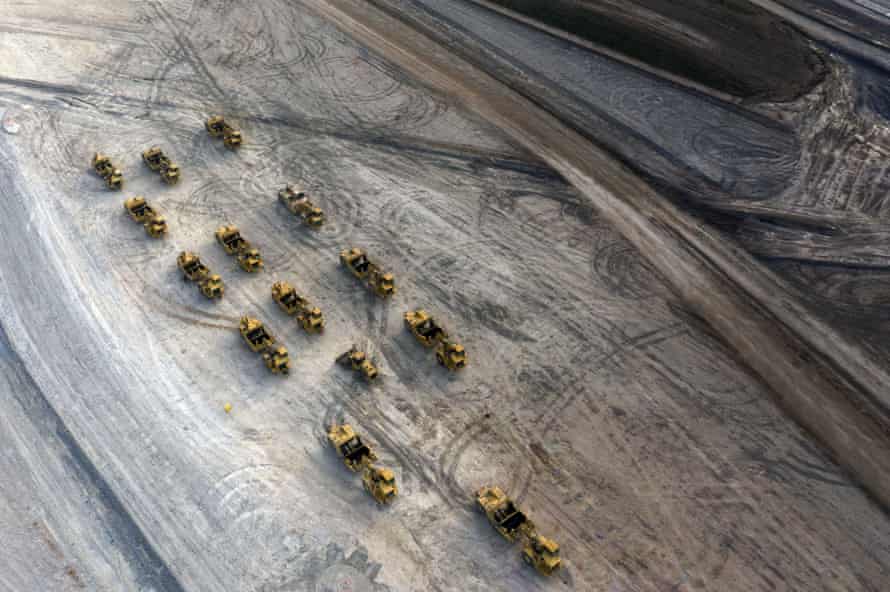
“Australians deserve a better future and if we don’t design for the changing climate, dwellings will ultimately be uninhabitable and we know that is worse in areas of disadvantage,” says Davina Rooney, chief executive of the Green Building Council.
“We will be entrenching energy poverty, and the consequences are quite substantial.”
But there are fears the impact of climate change has been compounded by slapdash urban planning and shortsighted design preferences, which have favoured big sprawling houses with dark roofs, black driveways and small yards over more energy-efficient properties.
It was only in August that planning controls were implemented banning dark roofing in Sydney’s south-western growth area and specifying room for trees in back yards.
Rob Stokes, the NSW planning minister, said the changes marked a new direction from decades of development on Sydney’s fringes.
“When designing lots for detached housing, we need back yards which are big enough to plant a tree or have a garden,” Stokes said. “We need to say goodbye to the trend of having dark roofs that not only attract and retain heat and raise ambient street temperatures, but lead to astronomical electricity bills because of the need to cool homes.”
Sebastian Pfautsch, associate professor of urban studies at the University of Western Sydney, says the region is an important marker for other capitals, since it has one of the fastest growing urban populations in Australia.
“The mistakes [in urban design] being made in western Sydney are being made in Melbourne, Brisbane, Perth. We’re not really thinking [about] how … we deal with the changing climate, particularly heat.”
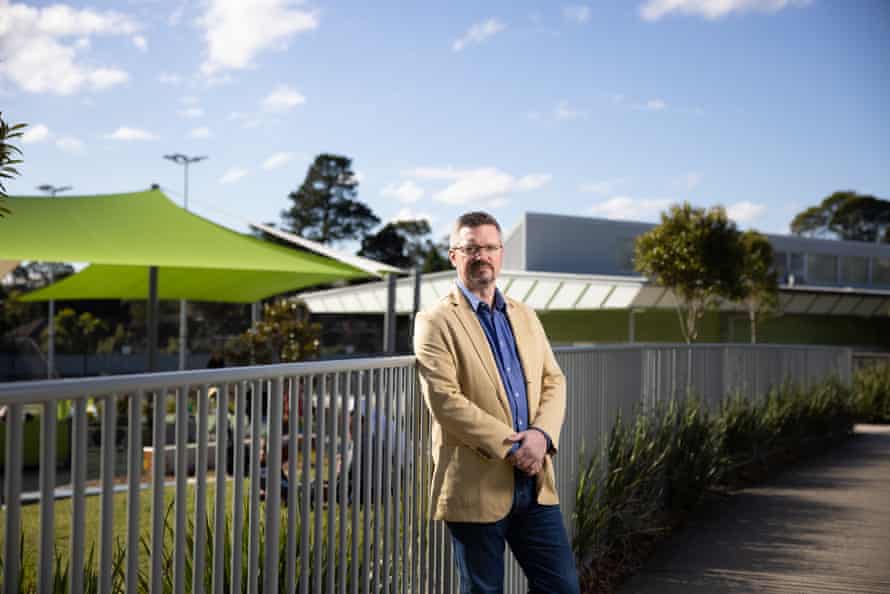
How did we get here?
Successive governments in NSW have talked about “liveable suburbs” as they grapple with waves of migration, demand for housing and soaring property prices.
The state’s population will swell by 3.3 million to more than 11 million by 2061, according to the latest intergenerational report, requiring 1.7m extra homes.
More than half that growth will come from immigration. Many of these new arrivals are leaving behind crowded cities and have chosen Australia because of the lifestyle it offers. Those who come to Sydney will overwhelmingly settle in the western suburbs, and for many that will mean new houses in areas long designated for expansion.
Quick GuideHow to get the latest news from Guardian AustraliaShow

Email: sign up for our daily morning briefing newsletter
App: download the free app and never miss the biggest stories, or get our weekend edition for a curated selection of the week’s best stories
Social: follow us on YouTube, Facebook, Instagram, Twitter or TikTok
Podcast: listen to our daily episodes on Apple Podcasts, Spotify or search “Full Story” in your favourite app
Many of the developments now being built were planned under Labor a decade ago under its Draft Metropolitan Strategy. Areas of the north-west around Rouse Hill, and the south-west around Oran Park and Leppington, were earmarked for development in the 2000s.
Labor set out to address the planning failures of the 1990s, when areas of the north-west were opened up with no public transport, resulting in horrendous commutes and choked roads.
Labor pledged it wouldn’t build any more suburbs before it had committed to rail infrastructure. Railways to Rouse Hill and Leppington have now been built, although their completion lagged well behind development of the suburbs.
After leaving parliament, the former planning minister Frank Sartor recalled the pressures he felt from colleagues to allow developers to open up new areas, despite the stated policy of ensuring infrastructure was in place first.

Sartor claimed he came under pressure from colleagues on behalf of the Urban Task Force, a group Sartor described as “nothing more than a lobby group for land speculators dressed up in the clothes of a respectable property group”.
The group and its members were major donors to the ALP until the ban on political donations from developers was introduced in 2008.
Developers hated some of the decisions that defined new release areas – such as the introduction of levies to help pay for infrastructure.
The levies had long-term consequences too. Because they were imposed per hectare of land there was an incentive to squeeze in as many blocks as possible, whereas a charge per house or lot would have encouraged a mix of block sizes.
Powerless councils
In NSW, if a planned dwelling satisfies the broad criteria of the building codes it does not have to go to the local council for individual assessment, under the rules known as “exempt and complying development”. This means that councils have little say over the final look and feel of the suburb.
“Zero setbacks” permitted as part of exempt and complying development mean that one wall of a house can be built right to the boundary of the lot, leading to cramped streetscapes where the eaves of neighbours almost touch each other.
“The problem is that the houses are flat and wide,” Pfautsch says. “They’re from fence to fence.
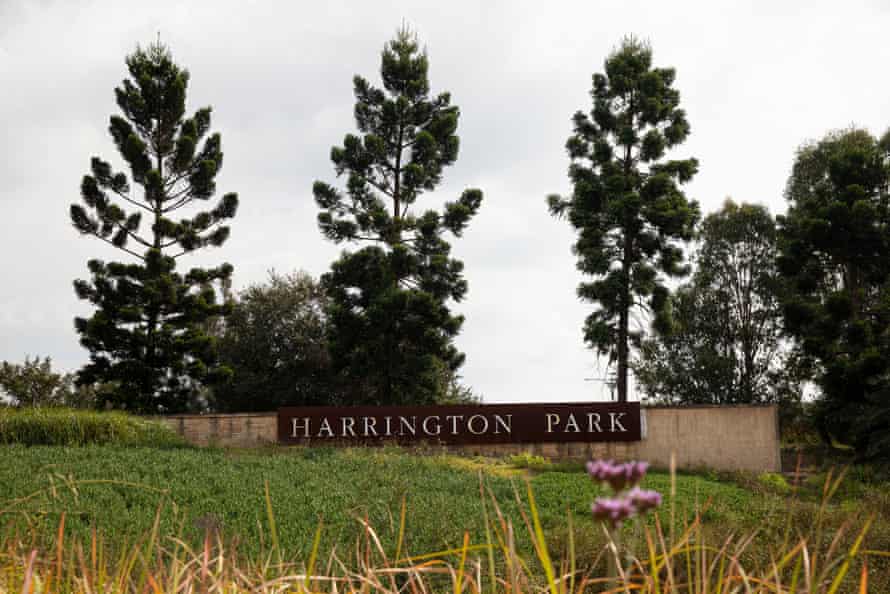
“The problem is with the state government. They say this new growth area will have 8,000 homes. If local government comes up with requests, the developer resists and just says: ‘We won’t do it’.”
Councils also struggle to enforce building codes.
NSW’s Basix rules, introduced in 2008 and designed to drive more sustainable housing, require water-saving native plants. Many councils also require a significant tree to be planted in the back yard of new houses.
But stretched councils rarely have the resources to check that the plants – often the last step in the building process – have been planted, let alone whether they have survived their first couple of summers.
The same goes for street trees – the developers put them in, but there is little attention given to whether they survive.
What do homebuyers want?
Developers stress that what they build is driven by demand – families want large single dwelling homes, not units.
Pfautsch agrees: “People who buy off the plan don’t want gardens, they want a big house.
“Two storeys are not favoured in the new estates, instead they choose sprawling houses … High rise would be much more sustainable. They could have open space around them and parks and community facilities.”
Pfautsch says that people who buy into these estates have been drained of resources buying the land and then try to put up the biggest, least expensive house possible. That means they don’t always have the budget for double glazing or other features that might improve liveability and energy efficiency.
Prof Bill Randolph, from the University of NSW’s City Futures research centre, says the size of plots is falling and housing is getting bigger.
“It’s what the market wants,” he says. “I don’t know why [development control plans] don’t require more open space. The floor-space ratios are quite permissive, and most unsustainable.
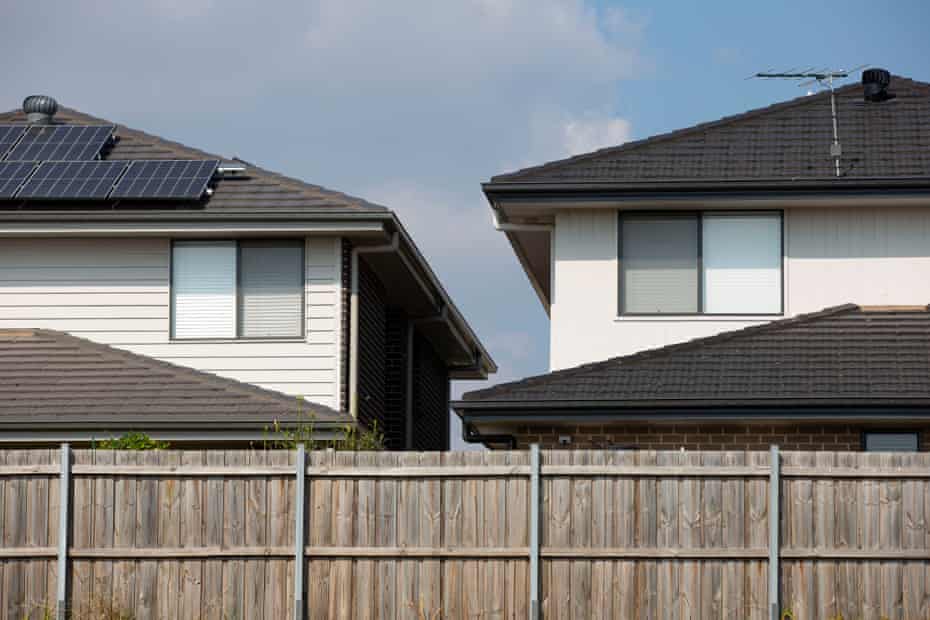
“Black roofs mean you need cooling systems and because they are built right to the boundary, often the air-conditioning systems are competing with each other and blowing hot air toward the neighbours.”
In 2007, Oran Park, the site of a former racetrack, was given the green light for accelerated development into a suburb of more than 9,000 homes, with an eventual population of 45,000.
The suburb has a masterplan and 38 hectares of open space has been reserved, but critics say little thought has been given to sustainability.
Oran Park was permitted to have much smaller lots than previously allowed, because the government wanted to meet its housing targets.
Land buyers then chose houses from display homes resulting in a mishmash of styles that filled the blocks. There are trees in the streets, but very few in the tiny yards.
Oran Park is served only by infrequent buses, which take residents to train stations at Campbelltown, 14km away, or Leppington, 12km away. Understandably, many residents rely on cars.
Ryan Azzopardi and Melissa Lauricella, a newly married couple, have been living in Oran Park for about a year.
They bought the land four years ago and then built a project home which they saw at a display village. The couple are very happy with their choice, and like the suburb, but their house has familiar energy drawbacks, despite having solar power installed.
The roof is dark, bricks are also a darker brown, with front pillars a lighter beige. Azzopardi says no one asked him about the colours of bricks and roof tiles.
“It’s a funny situation. The sun goes over the house, and in the morning it’s hot on one side, and in the evening it’s warm round the back. And in winter, it is freezing out the back of the house. But when summer comes around, and we get the intense morning sun, the rooms around the front can get really hot. It doesn’t get too discomforting, but it is noticeable.”
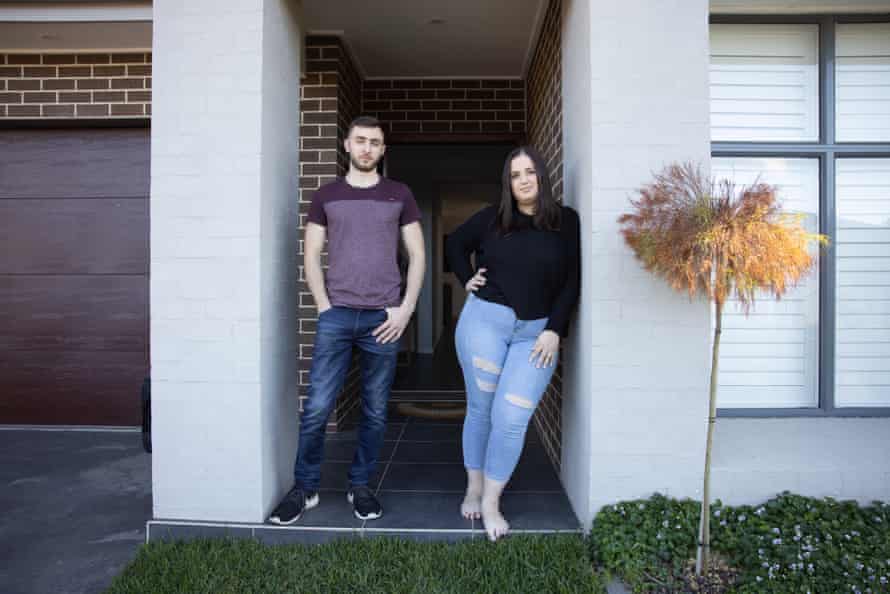
How can we do better?
State planning ministers have tried various means to drive more sustainable development. Sartor introduced the Growth Centres Commission in 2005 to speed land releases and tame the forces of the market.
The Coalition set up the Greater Sydney Commission in 2015 and appointed Lucy Turnbull, a former lord mayor of Sydney, as its initial chair. It was an effort to coordinate development across the metropolis, envisaging Sydney as three linked cities.
Some of the age-old failings were top of mind: ensuring infrastructure kept pace with new housing developments, ensuring there was enough housing in the future and making sure jobs were near where people lived.
It had a goal of creating “the 30-minute city,” an ideal maximum time for people to travel to work, childcare or shops. It talked about walkable neighbourhoods. And for the first time it talked about addressing urban heat. That meant more green space, greater tree canopy and more sustainable housing.
When Gladys Berejiklian became the premier in 2017, two measures designed to make cities more liveable were among her 14 stated priorities. The first was increasing the proportion of homes within a 10-minute walk of “quality green open and public space” by 10%, or 230,000 homes, by 2023.
As of January 2021, the government said it had met that goal for 100,000 homes.
The second was achieving an increase in the tree canopy by planting 1m trees by 2023. By March it was claiming to be halfway there. But the target does not measure trees cleared or the loss of farmland as Sydney keeps expanding.

Pushing the limits
Badgerys Creek on Sydney’s south-west fringe is the next frontier of large-scale urban planning. The so-called aerotropolis (recently renamed Bradfield) beside the new Nancy Bird Walton airport will be home to an eventual population of 1.5 million people.
Billed as “the beating heart of the Western parkland city”, Bradfield will be done differently, according to Planning NSW.
The department has announced precinct plans for three large areas that will have different purposes: an employment zone, a city core and residential area, and an agribusiness zone that will largely focus on food processing.
The planners promise “excellent access and connectivity, provided through public infrastructure” and “excellent liveability, where a ‘beyond business as usual’ approach will focus on creating a cooler and greener city”.
“In this place, blue/green systems will be particularly important, forming the basis for a more sustainable, resilient plan, one that respects and connects with country,” the key documents say.
A draft sustainability report from consultants Alluvium says it is possible to have “a greener more resilient Western Sydney area with up to 7C of cooling on extreme heat days provided by better design, greening and irrigation”. It says extreme and strong heat stress days can be reduced from 47 to 19 days each summer.
The report says this will be achieved by larger natural areas of vegetation to provide cooling and biodiversity, water bodies to provide evaporative cooling through misting and irrigation breezes, and more vegetation, including green roofs, walls and facades providing shade, insulation and evapotranspiration.
Green space needs to be placed upwind of significant areas and “high albedo” (lighter coloured) building materials should be used to reflect light and heat, while shade should be provided through eaves, overhangs, ventilation and street trees that need deep soil planting spaces and passive irrigation.
It all sounds promising, but no one expects the good intentions to translate easily into reality.
The wildlife assessment management report, also part of the publicly released planning documents, warns that the airport itself is a threat to achieving the vision because green initiatives will “increase the risk of bird strike”.
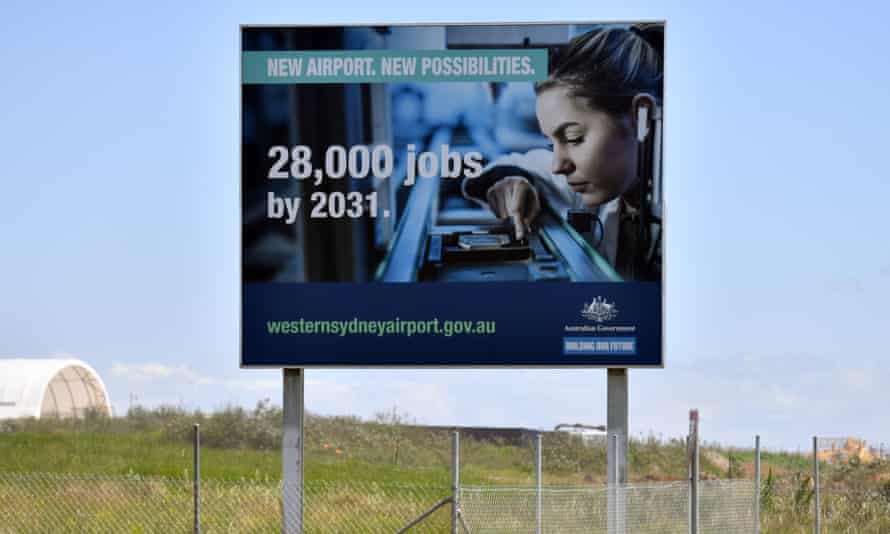
“Safeguarding the 24/7 operations of the airport and the vision of the Western Sydney Aerotropolis are essentially at odds,” it states.
And this is before the powerful forces of commercial development bear down on the planners.
Outside observers remain cautious. Rooney, of the Green Building Council, says: “The Greater Sydney Commission has put out a very strong vision for a green Aerotropolis and … the planning concepts are very focused on bringing green living spaces. But obviously the devil is in the detail of planning implementation. It’s just too critical for this not to be delivered.”
Events in the north-west offer a further reason for pessimism.
At Jordan Springs, the developer Lend Lease promised “tree-lined streets, picturesque parks and a thriving mix of community-focused businesses”.
In fact Jordan Springs has many of the same attributes as Oran Park – few trees, small lots and dark-roofed houses that stretch to the property boundaries.
But it is the NSW government’s recent decision to reverse its requirement for an employment zone that has planners and local residents worried.
In October 2020, at the height of the concerns about a Covid-induced downturn in the housing industry, Stokes announced that the 38 hectares reserved for a jobs hub would instead be turned into 500 more houses, and fast-tracked.
Geoff Brown, a local resident and activist, told the ABC it was a terrible deal for local workers.
“How is that a net benefit for NSW? A long-held promise [of] 38.4 hectares of employment land and thousands of ongoing local jobs, scrapped for 500 homes and just 252 temporary construction jobs.”
Onus on government
Perhaps the big picture answer is that more Australians should opt for denser living, allowing more space for parkland and community facilities.
But even if we continue to build on the fringes while also building more apartments around railway stations and in the inner city, Prof Bill Randolph of City Futures says the challenge is the same: good planning lies in a much higher level of government intervention to ensure and prioritise sustainability.
“The origin [of the problem] is the department of planning and their determination to get the numbers of dwellings [up], and the development industry. The prime criteria for both is the development numbers. It’s not sustainability or liveability.”
Randolph says the hands-off approach by government is particularly obvious in urban redevelopment around railway stations and is responsible for the lack of urban green space.
“In urban renewal areas developers have to buy expensive land. No one wants the park. The government doesn’t buy up the land then develop it, it leaves it to the private sector. The planning system acts as an enabler to the market rather than thinking about sustainability.”
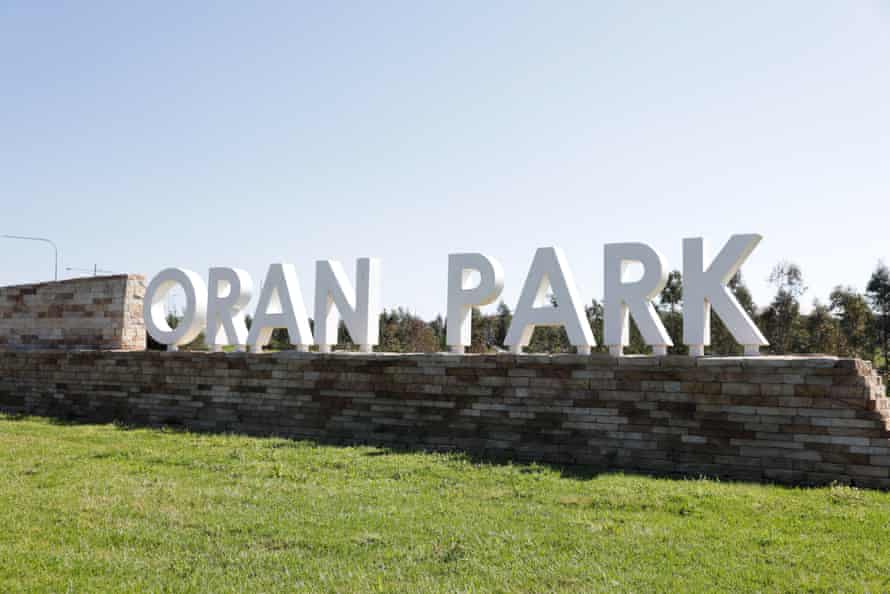
He believes the state government should take a much more hands-on role in shaping new urban areas, as occurs in other countries.
Rooney agrees: “If we look at long-term sustainable projects like Barangaroo, which has been delivered as a net zero precinct, it had incredibly strong governance and government leadership through a really long trajectory,” she says.
She says an important step is the update the national construction code, which can ensure buildings are fit for a changing climate.
“It’s been a decade since we have updated the national building code. We need to have an ecosystem that lifts standards,” she says.
The new code has been on exhibition for the last three months and will be in place by late 2022. It proposes upgrades to standards for glass, insulation, water heaters and other materials to drive thermal efficiency.
“There will be a lot of discussion about the cost of making homes better but we have to really lean into the long-term value.
“We need net zero homes. There is a commitment to a trajectory and now we need that to happen. There is a whole lot of green infrastructure – we know that with large green spaces, light-coloured roofs, tree cover, that we can change the temperature. Then we need to look at other elements like public transport, walkability, a sense of community.”
She also suggests that the pandemic, far from being an excuse for backing off higher standards, should be a catalyst for change.
“The community has become aware of the value of green space. Councils have put in pop-up cycleways and pop-up outdoor dining. I think there has been a community renaissance of their understanding of green spaces.”